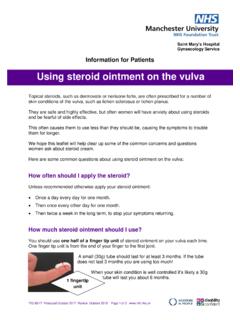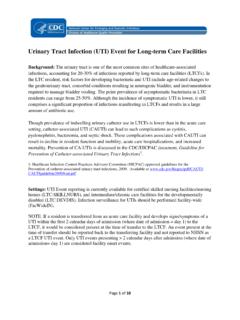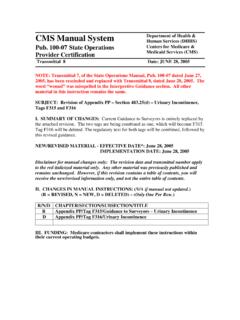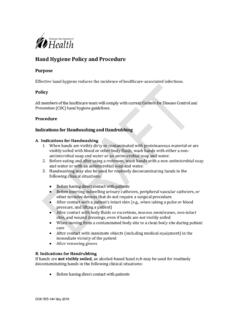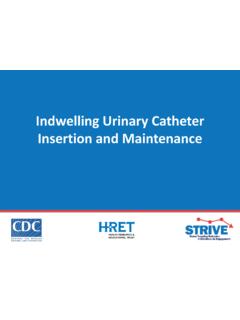Transcription of Flushing of an Indwelling Catheter & Bladder Washouts
1 TIG 62/21 Updated: March 2021 Review: Date March 2023 Page 1 of 5 Royal Manchester Children s Hospital Information for Patients Flushing of an Indwelling Catheter & Bladder Washouts This leaflet is designed to give you information about why you may need to flush your Catheter and how to carry out a Bladder washout or flush at home. What is a Catheter flush/ Bladder washout? A Catheter flush and Bladder washout are essentially the same procedure. They help to remove any debris that may be in the Bladder , which can lead to blocking the Catheter , preventing it from draining. Catheter flushes tend to be carried out as and when required. Catheter flushes and Bladder Washouts can be carried out as and when required, or routinely (for example once or twice a day) to prevent a build-up of mucus within the Bladder .
2 The procedure is carried out using a Bladder syringe and Sodium Chloride (salty water) flushed through the Catheter . You will be told prior to discharge how much Sodium Chloride (salty water) to use and how often to perform the flush/washout. How do I know when to perform a Catheter flush/ Bladder washout? You should be given advice and instructions before you are sent home about when you should perform this procedure. Sometimes we will ask you to do it every day, sometimes several times a day, to keep the Bladder clean and prevent catheters blocking. Sometimes you only need to flush the Catheter if and when there is a problem, such as when it appears to be blocked. Some of the signs the Catheter might be blocked and may need Flushing include: The Catheter has drained less urine in the last 1-2 hours compared to usual, or has not drained any urine at all in the last hour Abdominal pain Bladder spasms (squeezey pain in the Bladder that comes on very suddenly) Abdominal distention (your tummy is bigger or feels harder than usual) Urine bypassing the Catheter (when the wee comes out around the Catheter ) Feeling the need to urinate/wee TIG 62/21 Updated: March 2021 Review: Date March 2023 Page 2 of 5 Even if you are performing a routine washout every day, you may occasionally need to do a flush in-between if you notice the Catheter might be blocking.
3 If a Catheter remains blocked for several hours, urine is unable to drain out of the Bladder which can mean the Bladder becomes over stretched and this can potentially make you poorly. It is very important to monitor how much urine is draining every 1-2 hours and flush the Catheter if you are concerned. If you are still concerned after you have flushed the Catheter then you must seek further medical advice. How do I perform a Catheter flush/ Bladder washout? Performing a Catheter flush/ Bladder washout is a very straightforward procedure and can be carried out by either the child (under supervision of an adult) or a parent. You should be shown how to carry out the procedure before you are discharged home, but we have also included some step by step instructions below which you might find useful.
4 Equipment Bladder syringe (50ml Catheter tip) Sodium Chloride at room temperature Clean plastic bowl Blue Clamps Antiseptic wipe/wet wipe Step by Step Instructions 1) Wash and dry hands using 7 step technique 2) Clamp the Catheter above bag/flip-flo Catheter valve connection 3) Wipe connection to bag/valve with antiseptic wipe/wet wipe for 30 seconds and leave to dry for 30 seconds 4) If using a Catheter bag, disconnect from end of Catheter , keeping bag end protected from contamination 5) If using a flip-flo Catheter valve, open the valve 6) Attach the empty Bladder syringe to the end of the Catheter /valve, unclamp the Catheter and gently draw back to check if there is urine in the Bladder . Gently aspirate until the urine stops draining/there is resistance.
5 This is to check the Bladder is empty before you start the flush/washout TIG 62/21 Updated: March 2021 Review: Date March 2023 Page 3 of 5 7) Clamp the Catheter and remove the syringe 8) Draw up 20-50mls (dependent on how much you have been advised) of Sodium Chloride into the Bladder syringe and expel any air from the syringe by holding it upright 9) Attach the syringe to the end of the Catheter , unclamp and gently instil the Sodium Chloride. If pain is felt, do not continue with the flush and seek medical advice 10) Keeping the syringe attached, gently draw back the Sodium Chloride. If resistance is felt STOP. Forceful aspiration could cause damage and discomfort 11) Discard urine/debris aspirated into the bowl 12) Repeat steps 7-11 until the urine/water that returns is clear and no debris can be seen in the syringe.
6 If at any time the child complains of discomfort STOP 13) Once the washout/flush is completed, reconnect free drainage bag or Catheter flip-flo valve and ensure Catheter is unclamped 14) Wash the syringe and bowl well in warm soapy water, rinse and store in a clean dry place. Equipment should be changed over on a weekly basis as a minimum 15) Wash hands using 7 stage technique Troubleshooting When I aspirate the Catheter before the flush, no urine drains If your child s Catheter is on free drainage into a bag, it is possible their Bladder is empty which is why you are unable to aspirate any urine. However, it can also be a sign the Catheter has moved slightly and is no longer in the Bladder . There are a few things you can do to troubleshoot this issue at home, before seeking medical advice: Check you ve undone the clamps Check the Catheter tubing isn t bent or kinked Gently massage the tubing to try to release any potential debris Ask your child to sit in a different position lying down vs.
7 Sitting up and see if you can then aspirate urine Leave the Catheter clamped for 15-20 minutes and try aspirating again. This may give the Bladder time to fill with some urine, enabling you to check it is still safely within the Bladder Try instilling a small amount of Sodium Chloride very gently and slowly into the Bladder , if pain is felt, stop immediately and seek medical advice as the Catheter may be in the wrong place I cannot insert the Sodium Chloride as there is resistance There are lots of reasons why you may not be able to push the Sodium Chloride into the Bladder . You should ve aspirated the Catheter first, and if you managed to aspirate out urine, this helps you to feel reassured that the resistance is not due to the Catheter being in the wrong place (displaced).
8 There are a few things you can do to troubleshoot this issue at home, before seeking medical advice: Check you ve undone the clamps Check the Catheter tubing isn t bent or kinked Gently massage the tubing to try to release any potential debris Ask your child to sit in a different position lying down vs. sitting up and see if you can then instil the Sodium Chloride Try gently aspirating the Catheter again to dislodge a potential blockage I have aspirated back less Sodium Chloride than I put in This is one of the most common things parents report and is usually nothing to worry about. The way that catheters sit within the Bladder sometimes means that you can t always aspirate all the fluid back out. If you get approximately 50% back of what you put in, it is safe to repeat the flush (if necessary and debris is seen in the aspirate).
9 If you can t get 50% back then wait 10-15 minutes, encouraging your child to move around a little, and then try to aspirate again. If you are still unable TIG 62/21 Updated: March 2021 Review: Date March 2023 Page 4 of 5 to aspirate back, reconnect the bag (if using) and monitor the Catheter to ensure it is draining well. If you continue to have concerns, please seek medical advice. My child says it hurts whenever I do the flush/washout The Bladder has lots of nerves inside which means it can be sensitive to subtle changes. Sometimes the feeling of Sodium Chloride filling the Bladder can be uncomfortable, especially if the solution is cold. We recommend always using Sodium Chloride at room temperature to help make the procedure as comfortable as possible.
10 If the discomfort persists, seek medical advice. The washout solution never has any debris in it This could mean that your Bladder is very clean, or it could also mean the washout isn t very effective. When instilling the Sodium Chloride, it s important to do it with a little bit of speed as this helps to irrigate the Bladder and disturb any debris that is sat at the bottom of the Bladder . If you consistently do not see debris, but the Catheter continues to block, please contact the nurse specialists for further advice. The Catheter is blocking all the time Whilst Flushing is a very safe and effective way of preventing a build-up of debris and unblocking catheters, we understand it is not practical to do constantly throughout the day and night. If you are needing to flush the Catheter more than 3 or 4 times a day then please contact the nurse specialists for further advice as it may be that they will need to review the Catheter or it could potentially need changing.




